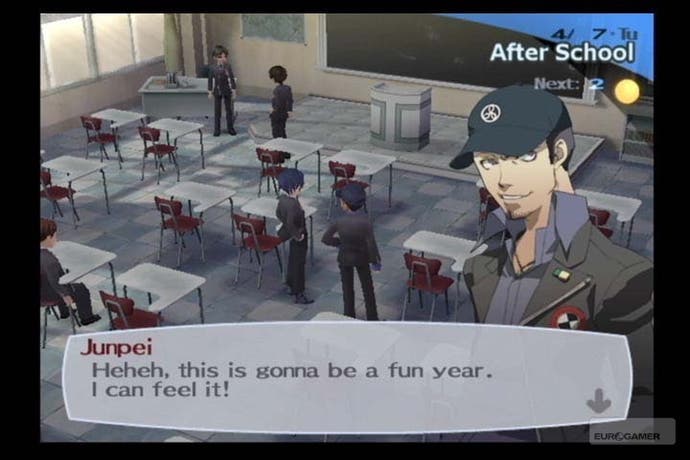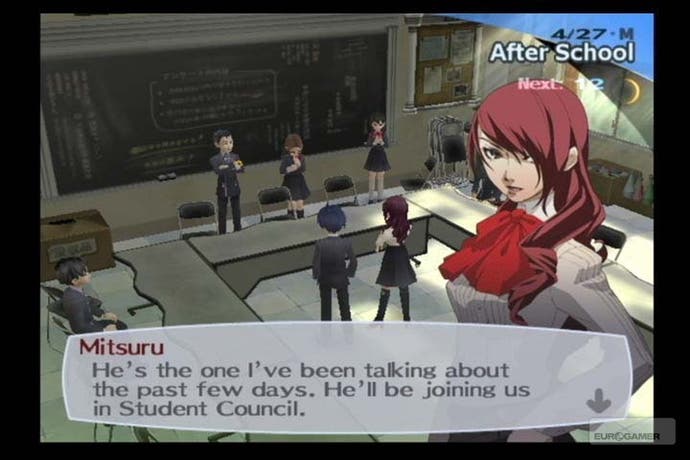Shin Megami Tensei: Persona 3
Shoot yourself in the head.
Part of us sullenly rebels against powering on the PS2. Standard definition, without even the consolation prize of innovative controls? No online features, no Achievements, no downloadable demo or add-on content? So quickly have we become accustomed to the luxuries of next-gen that our trusty consoles of yesterday feel only a step away from banging rocks together.
As anyone with half an eye on the industry's boring statistics can tell you, though, the vast majority of people are still perfectly happy to play on their PS2s, unswayed as yet by the lure of connected, high-def, controller-waving gaming. Even from our lofty perch of tech-fetishism, surrounded by the blinking lights and sparkling gizmos of the next-gen, there are moments when we think they might have a point. Persona 3 is one of those moments.
The ego
Actually, it's rather more than a moment. There are easily fifty hours of gameplay in here if you choose to explore and admire the scenery; probably more like a hundred if you're really committed. Like top-notch role-playing predecessors such as Disgaea and the divisive Final Fantasy XII, it's a feast you can gorge yourself on or merely sample through an eminently satisfying tasting menu. Like both of those games, those who are hooked will be gorging for a long time.

So what is Persona 3? Well, to begin with, it's a bundle of contradictions. A spin-off from the dark, apocalyptic and sprawling Shin Megami Tensei series, it's actually the fourth Persona game - Persona 2, on the PlayStation, was divided up into a pair of volumes, each an individual game in its own right. Connected only thematically with the rest of the series, Persona as a whole is a light-hearted, funny and generally sunny simulation of high school romance - interspersed with scenes of violence, demonic possession and teenagers shooting themselves in the head. Another contradiction: it's an RPG with randomly generated dungeons to crawl, but is still really, really good.
You play a newly arrived student at a prestigious Japanese high school, staying in a dormitory with a number of other characters. These people, it transpires, go out at night after school to fight an evil, demonic legion called Shadows, who mostly appear in an enormous, hideous tower that sprouts in the place of the school at midnight. In an entirely unsurprising twist, you share their powers, and are asked to join them in their fight.
So far, that's a couple of hundred different anime series and at least a few dozen games in a nutshell - but Persona 3 sets about presenting this well-worn material with extraordinary gusto and creativity, reinventing the rules of such stories wherever it sees fit. The result is two games in one. During the day, you play a teenager making his way in a new town and new school. In a style reminiscent of classic Japanese dating sims like Tokimeki Memorial (hey, don't diss it - it's where Hideo Kojima cut his teeth), you progress through the school calendar befriending different people and choosing which ones to spend time with and what to say with them. This section gently encourages you to explore the town further, to find certain items, or simply to go and spend time at locations that provide a boost to your three core "Social" statistics of Academics, Charm and Courage. Levelling those up presents the possibility of meeting new people or expanding existing relationships.
It's all cute, sunny, compelling and filled with colourful characters (in a very literal sense). It's not quite as free or ambitious as something like Shenmue, in that your actions generally boil down to a small set of options (such as who to hang out with after school, or where to spend your evenings), but it's presented with wit and charm.
The id

The other game in Persona 3 is the more traditional RPG, in which you battle the forces of darkness with the select group of your school friends who have the power to do so. Each evening, upon your return to the dorm, you have the option to travel to Tartarus - the aforementioned tower that appears in the school grounds - and battle through a few more stages of enemies. Additionally, there are some events which roll around on specific dates (often when the moon is full) that won't be optional, which means that it's important to make sure your characters are fairly strong and well-equipped by that point.
The basic objective for much of the game is simply to explore Tartarus, something which you're left to do at your own pace for the most part. Every floor in the tower is randomly generated, so it changes each night, with the exception of boss floors that are interspersed throughout the ascent. Each boss floor includes a teleport device that gives you instant access to that floor in future. If you can't quite make it to the boss on one night, you still level up and gain new abilities and equipment, so you're better prepared to face the challenge next time.
The game has no random battles, instead offering you the ability to avoid or pre-emptively attack enemies while you explore. Once into the battle, the system is loosely turn-based - but you only have direct control over your main character. As well as using generic weapon attacks, each character can also act by using a Persona - an expression of their subconscious that can launch more powerful physical attacks, cast elemental magic or use healing, protection and status-effect spells. Each of your support characters (up to three of them) can be given general orders, but will act fairly intelligently by themselves, leaving you to focus your strategy on your main character.




